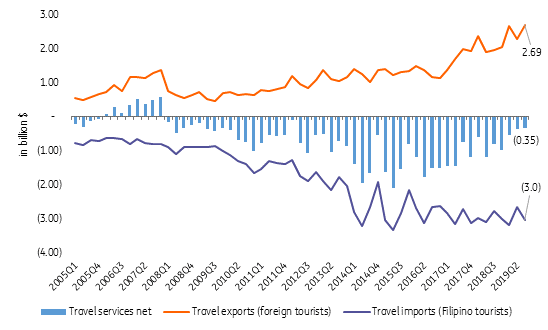Philippines: Covid to slow tourist arrivals and Filipino outbound tourists too
Covid-19 may slow tourist arrivals to the Philippines but it will also ground Filipino outbound tourists in the process, helping the peso
Philippines downgrades growth outlook to 5.5-6.5% accounting for tourism impact
With the brunt of the Covid-19 virus yet to hit Philippine shores, economic managers have begun to trim growth expectations given the projected hit to the burgeoning tourism industry. Tourism Secretary Bernadette Romulo-Puyat had ambitious plans for the sector. But the coronavirus will likely cause global travel to grind to a halt with outright travel bans in some places and anxiety about catching the virus persuading would-be travellers to stay at home. The Department of Tourism (DoT) indicates that up to 50,000 jobs are at risk with the sector employing roughly 5.4 million of the labour force while the economic planning agency has whittled down growth projections to 5.5-6.5%, a full percentage point hit from Covid-19.
Philippines: travel services exports and imports

Tourist arrivals to slow.. why is the peso not reacting?
The Philippines welcomed 8.26 million foreign visitors to the archipelago in 2019 with tourist receipts hitting $9.31 billion, translating to roughly $128 spent by each tourist based on the average number of days spent in the country. Visitors from South Korea, China and Japan comprised the top three in terms of country of origin and the Philippines will likely not be welcoming many visitors from these jurisdictions in the near-term or until Covid-19 is successfully contained. But despite the projected loss of roughly $9.3 billion worth of foreign currency inflows, the peso has remained relatively stable. The explanation for this could be that the projected loss of tourist receipts will be offset by the reduction of foreign exchange outflows from Filipino outbound tourists.
The Filipino outbound tourist may be grounded too
Travel services as recorded in the balance of payments (BoP) for the Philippines indicate that over the years, the amount of foreign exchange spent by Filipino residents abroad has generally outweighed the haul of tourist receipts since 2008. 2Q15 saw net travel services hit by -$2.1 bn, meaning Filipinos’ holiday spending outpaced tourism receipts by as much as $2.1 bn. And although Covid-19 will likely slow the influx of foreign tourists to the Philippines, potentially costing around $9 bn in lost tourism receipts, the virus will also likely ground outbound Filipino tourists, helping to keep much-needed foreign currency onshore.
Peso not a likely victim to slower tourism, but jobs at risk
The peso continues to outperform regional peers given analysts’ expectations that the Philippines will be the least impacted by Covid-19 given its relatively low exposure to China in terms of tourism and trade. Actual data from the Bangko Sentral ng Pilipinas (BSP) supports this analysis, with the peso more likely to be affected by developments in trade and financial flows after the Fed’s surprise rate cut. One area that will likely be affected would be the job security of Filipinos in the tourism sector with the government readying measures to support the industry which provides 13% of total employment. One area that the DoT has explored would be to tap local residents to fill the void of foreign tourists. In 2018, outbound Filipino tourists spent $616.88 bn abroad, a sizeable amount that could help support the Philippine tourism industry if they are able to coax local patronage. One complication, however, is that Covid-19 has been transmitted locally as well, which could deter potential Filipino tourists from swapping weekends in Tokyo with weekends in Manila or Cebu.
This publication has been prepared by ING solely for information purposes irrespective of a particular user's means, financial situation or investment objectives. The information does not constitute investment recommendation, and nor is it investment, legal or tax advice or an offer or solicitation to purchase or sell any financial instrument. Read more
Tags
PhilippinesDownload
Download snap
9 March 2020
Good MornING Asia - 10 March 2020 This bundle contains 2 Articles